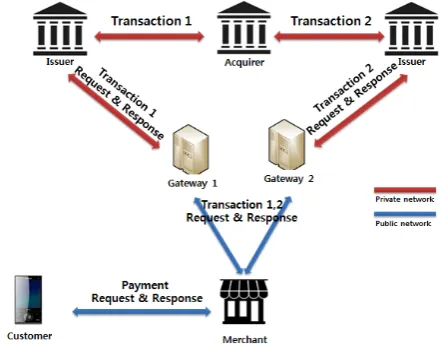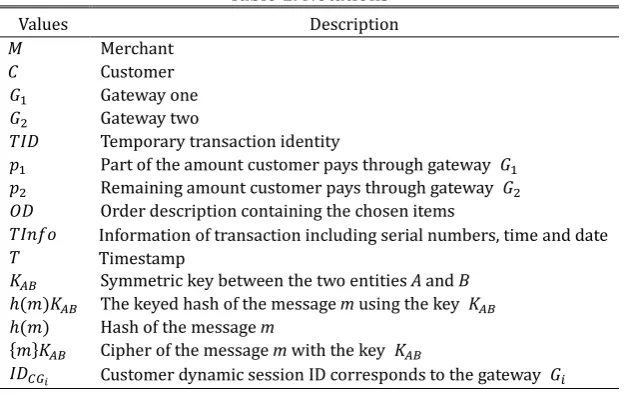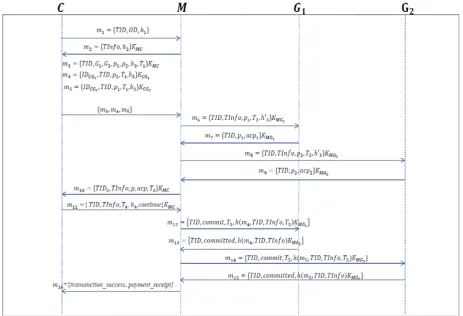A Security Enhanced Lightweight Mobile Payment Scheme
Based on Two Gateways
Hakjun Lee, Jiye Kim, Jongho Moon, Dongwoo Kang, Dongho Won
*Department of Computer Engineering, Sungkyunkwan University, 2066 Seoburo, Suwon, Gyeonggido 16419, Republic of Korea
* Corresponding author. Tel.: +82-31-290-7213; email: dhwon@security.re.kr Manuscript submitted October 12, 2016; accepted March 14, 2017.
doi: 10.17706/ijcce.2017.6.2.83-90
Abstract: The number of m-commerce users is exponentially increasing and the m-commerce has become popular because m-commerce allows us to pay for goods or services anytime, anywhere using mobile devices. A number of the mobile payment scheme has been proposed to ensure security requirements on m-commerce. However, several of them are vulnerable to various attacks. This paper proposes an enhanced lightweight mobile payment scheme based on two gateways. We show that the proposed scheme ensures necessary security requirements such as accountability, untraceability, unlinkability and double spending prevention. In addition, it is suitable for lightweight mobile payment environments by analyzing and comparing it with the related mobile payment scheme.
Key words: m-commerce, mobile payment, accountability, untraceability, unlinkability.
1.
Introduction
With the rapid development of network technologies, the number of m-commerce user is exponentially increasing because users can make the electronic payment on mobile devices such as tablets and smartphones [1] [2]. Since such mobile devices have low-power, limited memory and low-computational capacity, the m-commerce needs to employ lightweight payment protocols. In recent years, various authentication protocols for secure mobile payment have been proposed using NFC, smart card, and biometrics [3]-[9].
Sureshkumar et al. [10] introduced two gateway based payment scheme, and then Sureshkumar et al. [11] also proposed an enhanced lightweight protocol based on two gateways using dynamic identity. They claim that their scheme satisfies security requirement for mobile payment such as unlinkability, accountability and untraceability, and reduces computational complexity than other related works. However, their schemes have some drawbacks.
In this paper, we propose a security enhanced lightweight mobile payment scheme based on two gateways to solve the drawbacks of existing schemes. Our proposed scheme meets the various security requirements such as accountability, untraceability, unlinkability, double spending prevention and DoS attack prevention. The comparisons of security and computational complexity with related works show that our scheme is definitely improved and more practical in lightweight mobile payment environments.
scheme and compare it with those of related works in Section 5. Section 6 is a brief conclusion.
Fig. 1. Mobile payment mechanism based on two gateways.
2.
Related Works
In 2015, Luo et al. [2] proposed an NFC-based user registration scheme for mobile payment to provide user’s anonymity and unlinkability in the further transaction process. They use a virtual account issued by the issuer and a virtual card issued by the payment gateway to ensure anonymity of users and unlinkability in transactions. However, their scheme is vulnerable to DoS attacks and has symmetric key leakage problems. Furthermore, they use the public key cryptography and signature. Therefore, their scheme is not suitable for lightweight payment environments. In 2016, Sureshkumar et al. [9] proposed a lightweight two gateway based payment scheme with dynamic identity. Their scheme uses a symmetric key encryption. Therefore, their scheme is suitable for lightweight payment environments. However, their scheme also is vulnerable to DoS attacks and does not prevent double spending.
3.
The Proposed Scheme
In this section, we propose a security enhanced lightweight mobile payment scheme based on two payment gateway. The mobile payment mechanism for the proposed scheme is illustrated in Fig. 1. Our proposed scheme has four participants: the customer, the merchant, and two payment gateways. We assume that there is an internally secure network among the two issuers, the acquirer and the two gateways. That is, they communicate each other in secure channel. Therefore, in this paper, we focus on a lightweight payment process along with the customer, the merchant, and the gateways. The notations used in proposed scheme are shown in Table I.
3.1.
Assumptions
The customer has a bank account issued by the issuer, and two credit cards.
The customer individually registers credit information with credit cards and account information to the two gateways, respectively.
The gateways associate them to provide mobile payment service to the customer after verifying the customer’s identity. Next, the gateways and the customer share the initial dynamic identities 𝐼𝐼𝐶𝐺1 and 𝐼𝐼𝐶𝐺2 for ensuring customer anonymity and symmetric keys 𝐾𝐶𝐺1 and 𝐾𝐶𝐺2 for secure
communicationsusing the key establishment protocols.
The customer wants to purchase goods or service through the merchant’s website. However, the balance in any one of the credit cards is not enough to pay. But, the sum of balance for two cards is enough. Therefore, the customer will buy the product using two cards via different gateways.
Table 1. Notations
Values Description
M Merchant
C Customer 𝐺1 Gateway one
𝐺2 Gateway two
𝑇𝐼𝐼 Temporary transaction identity
𝑝1 Part of the amount customer pays through gateway 𝐺1
𝑝2 Remaining amount customer pays through gateway 𝐺2
𝑂𝐼 Order description containing the chosen items
𝑇𝐼𝑇𝑇𝑇 Information of transaction including serial numbers, time and date
𝑇 Timestamp
𝐾𝐴𝐴 Symmetric key between the two entities A and B
ℎ(𝑚)𝐾𝐴𝐴 The keyed hash of the message m using the key 𝐾𝐴𝐴
ℎ(𝑚) Hash of the message m
{𝑚}𝐾𝐴𝐴 Cipher of the message m with the key 𝐾𝐴𝐴
𝐼𝐼𝐶𝐺𝑖 Customer dynamic session ID corresponds to the gateway 𝐺𝑖
3.2.
Lightweight Mobile Payment Protocols
Fig. 2 illustrates our lightweight mobile payment protocols. Detail is as follows: 3.2.1. Phase 1 – Initiating payment
Initially, the customer selects goods or services through the merchant`s website, and starts initial payment phase with the merchant.
Step 1. The customer C generates his temporary transaction identity 𝑇𝐼𝐼 and order description 𝑂𝐼, and sends the payment request 𝑚1= {𝑇𝐼𝐼,𝑂𝐼,ℎ1} to merchant 𝑀, where the keyed hash value
ℎ1= (𝑇𝐼𝐼,𝑂𝐼)𝐾𝑀𝐶.
Step 2. After receiving the 𝑚1, the merchant generates transaction information 𝑇𝐼𝑇𝑇𝑇 and computes
ℎ2= (𝑇𝐼𝑇𝑇𝑇,ℎ2). The M then sends 𝑚2= {𝑇𝐼𝑇𝑇𝑇,ℎ2} to C 3.2.2. Phase 2 – payment with gateway
Step 1. The 𝐶 computes 𝑚3= {𝑇𝐼𝐼,𝐺1,𝐺2,𝑝1,𝑝2,ℎ3,𝑇1}𝐾𝑀𝐶 , 𝑚4= {𝐼𝐼𝐶𝐺1,𝑇𝐼𝐼,𝑝1,𝑇1 ,ℎ3}𝐾𝐶𝐺1 and 𝑚5= {𝐼𝐼𝐶𝐺2,𝑇𝐼𝐼,𝑝1,𝑇1,ℎ3}𝐾𝐶𝐺2 , where the hash value ℎ3= (𝑇𝐼𝐼,𝑇𝐼𝑇𝑇𝑇,𝑇1). The C sends
transaction request message {𝑚3,𝑚4,𝑚5} to M.
Step 2. After receiving the messages, the 𝑀 decrypts 𝑚3 and checks whether 𝑇1 is within a tolerable period and 𝑝=?𝑝1+𝑝2. If they hold, the 𝑀 computes 𝑚6= {𝑇𝐼𝐼,𝑇𝐼𝑇𝑇𝑇,𝑝1,𝑇2,ℎ′3}𝐾𝑀𝐺1, where ℎ′3= (𝑇𝐼𝐼,𝑇𝐼𝑇𝑇𝑇,𝑇1), andsends the transaction request {𝑚4,𝑚6} to gateway 𝐺1.
Step 3. The 𝐺1 decrypts the received messages 𝑚4 and 𝑚6, and verifies whether the timestamp 𝑇1 and 𝑇2 are within a tolerable period, and whether ℎ3 and ℎ′3 are equal. If they hold, the 𝐺1 checks the credit limit of 𝐼𝐼𝐶𝐺1. If 𝑝1 is larger than credit limit of 𝐼𝐼𝐶𝐺1, then sets 𝑎𝑎𝑝1=𝐹, else 𝑎𝑎𝑝1=𝑇. The 𝐺1 then computes the response message 𝑚7= {𝑇𝐼𝐼,𝑝1,𝑎𝑎𝑝1}𝐾𝑀𝐺1 , and sends it to M.
Step 4. The M computes 𝑚8= {𝑇𝐼𝐼,𝑇𝐼𝑇𝑇𝑇,𝑝1,𝑇2,ℎ′3}𝐾𝑀𝐺2 and sends the transaction request {𝑚5,𝑚8}
to gateway 𝐺2.
Step 5. The 𝐺2 decrypts the received messages 𝑚5 and 𝑚8, and verifies whether timestamp 𝑇1 and 𝑇2 are within a tolerable period, and whether ℎ3 and ℎ′3 are equal. If they hold, the 𝐺2 checks the credit limit of 𝐼𝐼𝐶𝐺2. If 𝑝2 is larger than credit limit of 𝐼𝐼𝐶𝐺2, then sets 𝑎𝑎𝑝2=𝐹, else 𝑎𝑎𝑝2=𝑇.
The 𝐺2 then computes the response message 𝑚9= {𝑇𝐼𝐼,𝑝2,𝑎𝑎𝑝2}𝐾𝑀𝐺2, and sends it to M.
Step 6. After receiving the response messages, the M decrypts the messages 𝑚7 and 𝑚9, and computes
Fig. 2. An enhanced lightweight mobile payment scheme based on two gateways.
3.2.3. Phase 3 – Commitment phase
Step 1. After receiving the 𝑚10, the C checks whether the total amount 𝑝 is correct and 𝑎𝑎𝑝 is true. If it holds, the C computes 𝑚11={𝑇𝐼𝐼,𝑇𝐼𝑇𝑇𝑇,𝑇4,ℎ4,continue}𝐾𝑀𝐶, and sends it to M in order to express that he/she wants to continue the payment processes, otherwise the customer aborts payment, where ℎ4= (𝑇𝐼𝐼,𝑇𝐼𝑇𝑇𝑇,𝑝,𝑇3).
Step 2. After receiving the 𝑚11, the merchant checks whether timestamp 𝑇4 is within a tolerable period and the customer wants to continue. If it holds, the merchant computes the commit message
𝑚12= {𝑇𝐼𝐼,𝑎𝑇𝑚𝑚𝑐𝑐,𝑇5,ℎ(𝑚4,𝑇𝐼𝐼,𝑇𝐼𝑇𝑇𝑇,𝑇5)𝐾𝑀𝐺1} and sends it to gateway 𝐺1.
Step 3. The 𝐺1 decrypts the received message 𝑚12, and checks whether timestamp 𝑇5 is within a tolerable period. If it holds, the 𝐺1 verifies keyed hash message value using 𝐾𝑀𝐺1. If it is valid, the 𝐺1
computes the response message 𝑚13= {𝑇𝐼𝐼,𝑎𝑇𝑚𝑚𝑐𝑐𝑐𝑡𝑡,ℎ(𝑚4,𝑇𝐼𝐼,𝑇𝐼𝑇𝑇𝑇)𝐾𝑀𝐺1}, and sends this
committed message to merchant.
Step 4. The M computes the commit message 𝑚14= {𝑇𝐼𝐼,𝑎𝑇𝑚𝑚𝑐𝑐,𝑇5,ℎ(𝑚5,𝑇𝐼𝐼,𝑇𝐼𝑇𝑇𝑇,𝑇5)𝐾𝑀𝐺2} and
sends it to 𝐺2.
Step 5. The 𝐺2 decrypts the received message 𝑚14, and checks whether timestamp 𝑇5 is within a tolerable period. If it holds, the 𝐺2 verifies keyed hash message value using 𝐾𝑀𝐺2. If it is valid, the 𝐺2
computes the response message 𝑚15= {𝑇𝐼𝐼,𝑎𝑇𝑚𝑚𝑐𝑐𝑐𝑡𝑡,ℎ(𝑚5,𝑇𝐼𝐼,𝑇𝐼𝑇𝑇𝑇)𝐾𝑀𝐺2}, and sends this
committed message to M.
Step 6. After receiving the 𝑚13 and 𝑚15, the M verifies whether keyed hash values contained in the both messages are valid. If it holds, the M sends traction success messages and payment receipt to the C.
𝐼𝐼𝐶𝐺1(𝑇𝑡𝑛) =ℎ(𝐼𝐼𝐶𝐺1(𝑇𝑜𝑡)||𝑇5)𝐾𝐶𝐺1
𝐼𝐼𝐶𝐺2(𝑇𝑡𝑛) =ℎ(𝐼𝐼𝐶𝐺2(𝑇𝑜𝑡)||𝑇5)𝐾𝐶𝐺2
Table 2. Security Comparison of the Proposed Scheme and Other Related Schemes
Features [12] [2] [10] Proposed scheme
Accountability Yes Yes Yes Yes
Untraceability Yes Yes Yes Yes
Unlinkability No Yes Yes Yes
Anonymity No Yes Yes Yes
Double spending prevention No Yes No Yes
DoS attack prevention Yes No No Yes
Table 3. Computational Complexity Comparison of the Proposed Scheme and Other Related Schemes
Features [12] [2] [10] Proposed scheme
Public-key en/decryptions 0 6 0 0
Digital signature 0 7 0 0
Symmetric-key en/decryptions 10 7 10 10
Hash functions 3 0 4 2
Keyed hash functions 3 0 10 6
4.
Security Analysis
In this section, we analyze our proposed scheme in terms of security and computational complexity. Table II shows security comparisons of our scheme and other related schemes. Table III shows a computational complexity comparison of the proposed scheme and other related schemes. These two tables said that the proposed scheme is lightweight in terms of computational complexity, and more secure than other mobile payment scheme.
4.1.
Accountability
In the proposed scheme, accountability issues are not caused because the commitment phase is performed after confirming the customer’s consent. In addition, the freshness of commitment messages is guaranteed by symmetric keys and timestamps. So the customer is able to start a fresh transaction for buying products or services.
4.2.
Untraceability
The customer uses a temporary transaction identity and different dynamic identities for the two gateways. Thus, different payments of a same customer cannot be linked. Therefore, our scheme satisfies untraceability property because an attacker is unable to distinguish a particular customer.
4.3.
Unlinkability
Unlinkability is a strong anonymity. In our scheme, an adversary cannot know a customer’s real identity. If the transaction information is revealed, nobody knows who the customer is. Thus, our scheme satisfies unlinkability property.
4.4.
Double Spending Prevention
the previous authentication message, and sends it to the merchant or gateway, the merchant and gateway can check the illegality of the message using checking the timestamp. In addition, because every authentication message is encrypted as well, the adversary cannot forge the timestamp. Thus, the proposed scheme can prevent double spending.
4.5.
DoS attack Prevention
In [9], the attacker can perform DoS attacks in the payment agreement phase because the merchant accepts any message and then response with encrypted messages. However, in the proposed scheme, the customer sends keyed hash value ℎ1. To verify ℎ1, both of the customer and the merchant need to have a key 𝐾𝑀𝐶. Therefore, the merchant checks if the customer is vaild. So the proposed scheme can prevent DoS attacks.
5.
Conclusion
This paper proposes an enhanced lightweight mobile payment scheme based on two gateways. The security analysis and comparisons show the proposed scheme meets the necessary security properties such as double spending prevention, DoS attack prevention, and etc. Furthermore, the proposed is efficient in terms of computational complexity, compared to other existing schemes. Therefore, the proposed mobile payment scheme is more suitable and practical for lightweight mobile payment environments. In the future work, we will simplify the proposed scheme to provide a more lightweight m-commerce protocol and maintain the security requirements. In addition, performance evaluation to analyze the actual operating time will be performed.
Acknowledgment
This research was supported by the Basic Science Research Program through the National Research Foundation of Korea (NRF) funded by the Ministry of Science, ICT, and Future Planning (2014R1A1A2002775).
References
[1] Yang, J. H., & Lin, P. Y. (2016). A mobile payment mechanism with anonymity for cloud computing. Journal of Systems and Software, 116, 69-74.
[2] Luo, J. N., Yang, M. H., & Huang, S. Y. (2016). An unlinkable anonymous payment scheme based on near field communication. Computers & Electrical Engineering, 49, 198-206.
[3] Chen, W., Hancke, G. P., Mayes, K. E., Lien, Y., & Chiu, J. H. (2010). NFC mobile transactions and authentication based on GSM network. Proceedings of 2010 Second International Workshop on Near Field Communication (NFC), (pp. 83-89). IEEE.
[4] Moon, J., Choi, Y., Kim, J., & Won, D. (2016). An improvement of robust and efficient biometrics based password authentication scheme for telecare medicine information systems using extended chaotic maps. Journal of medical systems, 40(3), 1-11.
[5] Choi, Y., Lee, Y., & Won, D. (2016). Security improvement on biometric based authentication scheme for wireless sensor networks using fuzzy extraction. International Journal of Distributed Sensor Networks, 12 (1).
[6] Moon, J., Choi, Y., Jung, J., & Won, D. (2015). An improvement of robust biometrics-based authentication and key agreement scheme for multi-server environments using smart cards. PloS one, 10(12), e0145263.
[8] Kim, J., Lee, D., Jeon, W., Lee, Y., & Won, D. (2014). Security analysis and improvements of two-factor mutual authentication with key agreement in wireless sensor networks. Sensors, 14(4), 6443-6462. [9] Tan, Z. (2010). An enhanced three-party authentication key exchange protocol using elliptic curve
cryptography for mobile commerce environments. Journal of Communications, 5 (5), 436-443.
[10]Sureshkumar, V., Anitha, R., Rajamanickam, N., & Amin, R. (2016). A lightweight two-gateway based payment protocol ensuring accountability and unlinkable anonymity with dynamic identity. Computers & Electrical Engineering.
[11]Sureshkumar, V., Anitha, R., & Rajamanickam, N. (2016). Hash based two gateway payment protocol ensuring accountability with dynamic ID-Verifier for digital goods providers. In Computational Intelligence, Cyber Security and Computational Models (pp. 369-384). Springer Singapore.
[12]Isaac, J. T., & Zeadally, S. (2012). An anonymous secure payment protocol in a payment gateway centric model. Procedia Computer Science, 10, 758-765.
Hakjun Lee received the B.S. degree in Software Engineering from Korea National University of Transportation, Korea, in 2015. He is currently a master student at Electrical and Computer Engineering from Sungkyunkwan University, Korea. His current research interest is in the area of cryptography, authentication protocol, and mobile payment.
Jiye Kim received the B.S. degree in Information Engineering from Sungkyunkwan University, Korea, in 1999 and the M.S. degree in Computer Science Education from Ehwa University, Korea, in 2007. She also worked as a software engineer for mobile phone manufacturers in Korea or Japan between 1999 and 2013. She is currently pursuing the Ph.D. degree in Electrical and Computer Engineering at Sungkyunkwan University. Her current research interests include cryptography, security protocols, and security of sensor networks in IoT environments.
Jongho Moon received the B.S. degree in electrical and computer engineering from Sungkyunkwan University, Korea, in 2012 and the M.S. degree in electrical and computer engineering from Sungkyunkwan University, Korea, in 2014. He also worked as a malware analyzer in SECUI between 2014 and 2015. He is currently pursuing the Ph.D. degree in electrical and computer engineering at Sungkyunkwan University. His current research interest includes cryptography, malware, forensic, and authentication or key management protocols.



